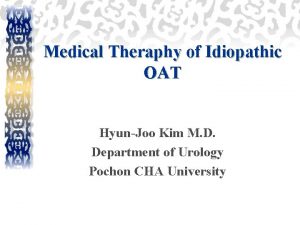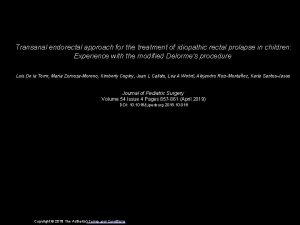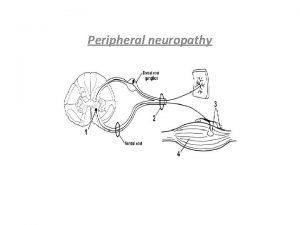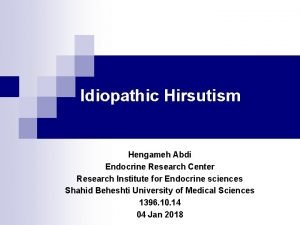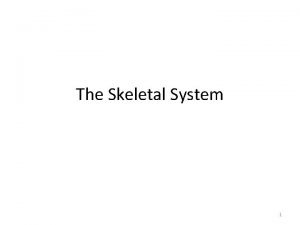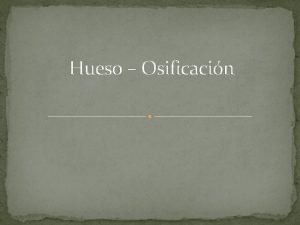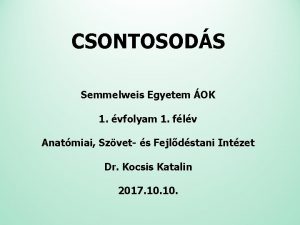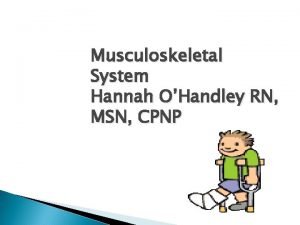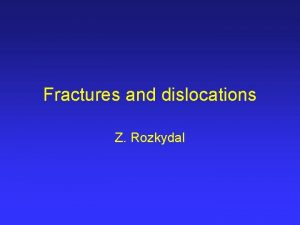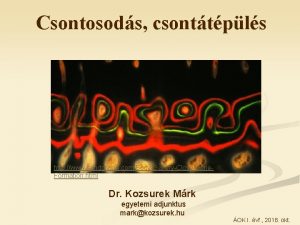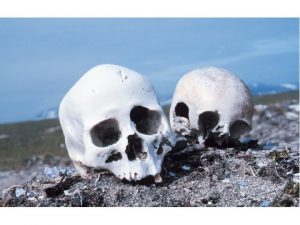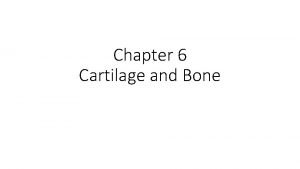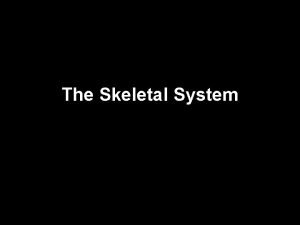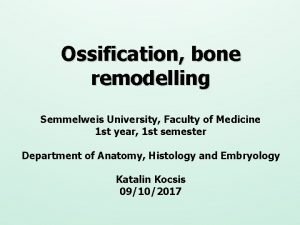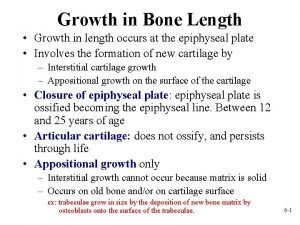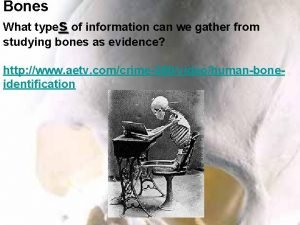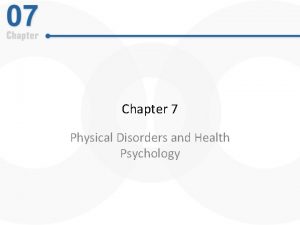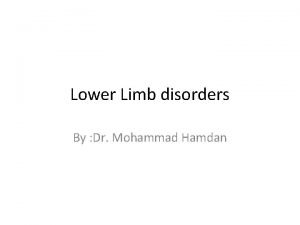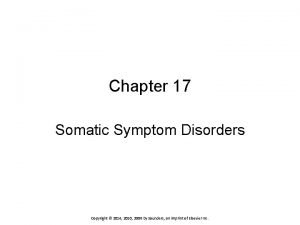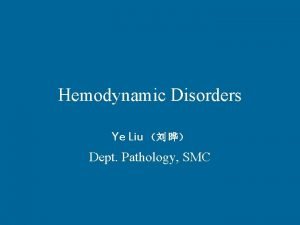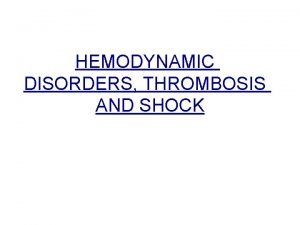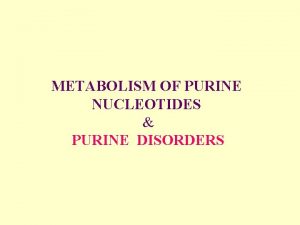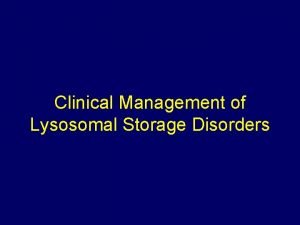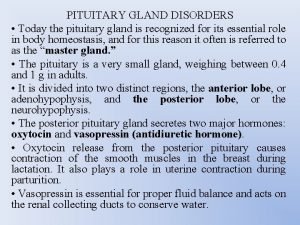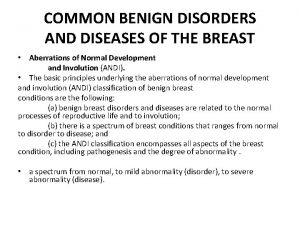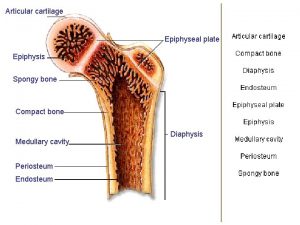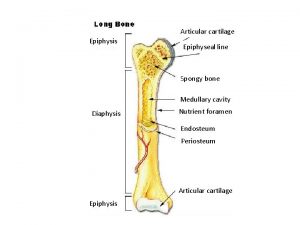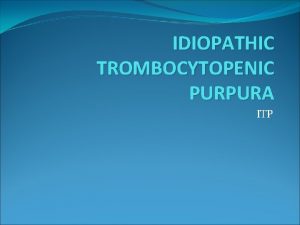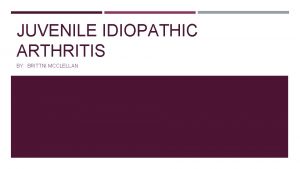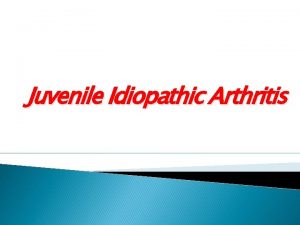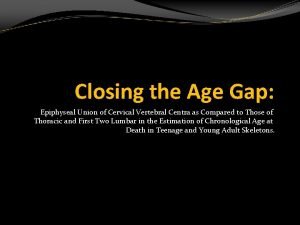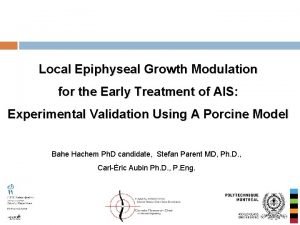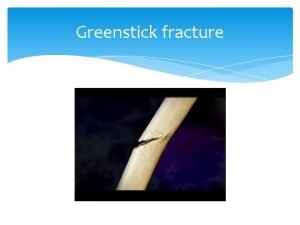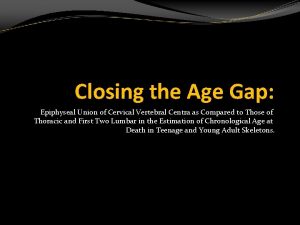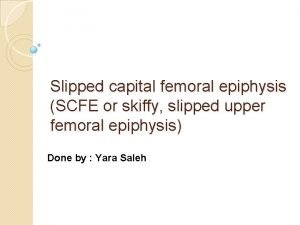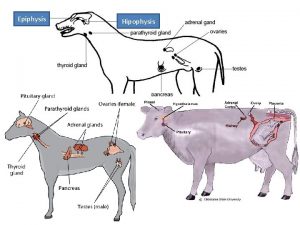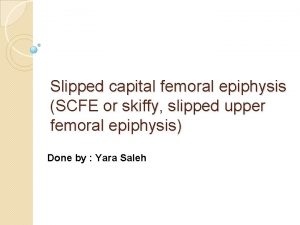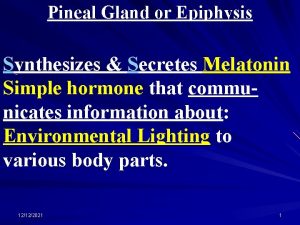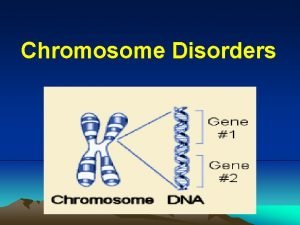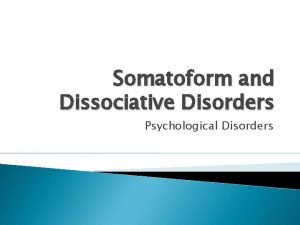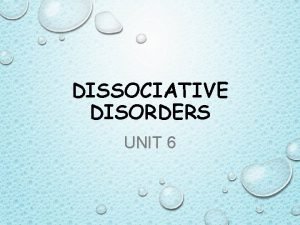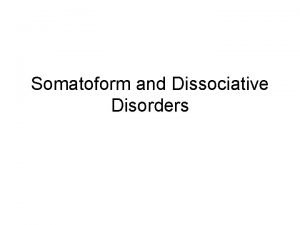Epiphyseal disorders Z Rozkydal Epiphyseal disorders Epiphysis Idiopathic

















































- Slides: 49

Epiphyseal disorders Z. Rozkydal

Epiphyseal disorders Epiphysis Idiopathic avascular necrosis of epiphysis of long bones Metaphysis Diaphysis Etiology unkown Metaphysis Obr. 1 Epihysis

Perthes disease It is a complication of the necrosis of proximal epiphysis of the femur 4 -12 years 10 % bilateral More often in boys Symptoms: limping, pain limited ROM (rotation, abduction) Obr. 2

Frejka classification 1. st. latency 6 - 18 months 2. st. necrosis 3. st. decalcination 4. st. recovery 5. st. consequences Obr. 3

Perthes disease- stages Obr. 4 Obr. 5

Perthes disease Ischemia of the whole epiphysis Articular cartilage continues to grow Bone is resorbed and replaced by wowen bone The bone is soft and vulnerable Subchondral fracture - showes the extent of damage New bone is gradualy revascularised New bone is plasticcan be deformed Obr. 6 Subchondral fracture of femoral epiphysis

M. Perthes 1. Ischemic stage: avascular necrosis growth arrest of epiphysis revascularisation from periphery ossification 2. Ischemic stage: trauma, subchondral fracture resorption under the fracture replacement by plastic woven bone subluxation, deformity

Catterall classification I. 25 % II. 50 % med. - lateral column III. 75 % IV. 100 % Obr. 7

Subchondral fx less than one half Subchondral fx more than one half

Catterall I Obr. 8 Catterall II Obr. 9

Catterall III Obr. 10 Catterall IV Obr. 11

Salter classification A Catterall I. a II. less then one half of the epiphysis short subchondral fracture lateral column intact conservative treatment Obr. 13 Obr. 12

Salter classification B Caterall III. a IV. more then one half of the epiphysis long subchondral fracture lateral column is absent operative treatment Obr. 15 Obr. 14

Examination X-ray Artrography CT - 3 D reconstruction MRI Scintigraphy Ultrasonography

Prognosis I. a II. stage III. a IV. stage good prognosis wrong prognosis Risk factors: Older age Loss of containment, subluxation Large extent Limited movements

Types of deformity in Perthes disesase

Management - containment of the head in the acetabulum - good range of motion Conservative methods - Atlanta orthesis Operative methods Osteotomy of the pelvis (Salter, Steel, Sutherland, Dungl) Shelf plasty Osteotomy of the femur

Stulberg classification of deformity of the femoral head in Perthes disease

Conservative methods Rest in bed Crutches Atlanta orthesis Obr. 16 Atlanta orthesis

Operative methods Salter pelvic osteotomy Obr. 17 Varus osteotomy of the femur Obr. 18

Salter osteotomy Obr. 20 Obr. 19

Perthes disease on the right hip after Salter osteotomy Almost normal hip in 18 years of age

Consequences of Perthes disease Coxa plana Shortening of the leg Limited movements Early osteoarthritis Better prognosis Younger age Less extent of danage No subluxation Obr. 21

Tibia vara Blount Disorder of proximal epiphysis of the tibia Early arrest of growth plate on medial side with smaller epiphysis Infantile – up to 3 years Juvenile - up to 10 years Th: orthesis, osteotomy Obr. 22

Tibia vara Blount Obr. 24 Obr. 25

Slipped upper femoral epiphysis Growth plate of proximal epiphysis of the femur is weak and soft Imbalance of growth hormon and sexual hormons Obese patients Fröhlich syndrom Adiposogenital syndrom 9 -15 years Bilateral in one third Obr. 26

Slipped upper femoral epiphysis Slipping of epiphysis down and backwards to varus and to retroversion Metaphysis goes proximaly and to external rotation Obr. 27

Symptoms Pain in groin and in the thigh Limping Shortening of the leg Limited abduction and external rotation Positive Trendelenburg sign Obr. 28

Types 1. Preslip (6%) 2. Acute slip (11%) 3. Chronic slip (after two weeks, 60 %) 4. Acute slip on chronic sliping (23%) Obr. 29

Stages Obr. 30 1. 2. 3.

Stages 1. Slight: slip up to 30% 2. Moderate : slip 30 -60 % 3. Severe: slip above 60 %

Management Fixation in situ (K wires, Knowles pins) Closed reduction and K wires Open reduction Osteotomy of proximal femur Southwick, Imhäuser-Weber

Fixation in situ Obr. 31 Obr. 32

Open reduction Obr. 33

Southwick osteotomy Obr. 34

Pertrochanteric osteotomy Obr. 35

Complication of slipped upper femoral epiphysis Avascular necrosis of the femoral head Chondrolysis of the femoral head Osteoarthritis of the hip

Necrosis of os lunatum m. Kienbőck Therapy Rest Immobilisation Removal and replacement by tendon, by os pisiforme or by arteficial material Obr. 36

M. Köhler I. - necrosis of navicular bone Therapy Rest Immobilisation Arthrodesis Obr. 37

M. Köhler II. M. Freiberg-Köhler Necrosis of metatarsal head Therapy Rest, padding Surgery: Removal of necrotic part Osteotomy Obr. 38

Avascular necrosis of femoral head in adults Etiology unknown Pain Limited movements Limping Obr. 39

Avascular necrosis of femoral head Obr. 40

Management Crutches Forrage, bone grafting Osteotomy-varus, valgus, derotation Arthrodesis Total hip replacement

Necrosis after fracture of the neck of the femur Obr. 41

Necrosis of the femoral head after coxitis Obr. 42

M. Ahlbäck – necrosis of medial condyle of the femur m. Osgood- Schlatter – proximal apophysis of the tibia Necrosis of sesamoid bone M. Panner – osteonecrosis of humeral head Vertebra plana Calvé Necrosis of apophysis of calcaneus

Literature Janíček, P. : Ortopedie. Lékařská fakulta MU v Brně, 2001. Spoluautoři: Dufek, P. , Chaloupka, R. , Krbec, M. , Poul, J. , Procházka, P. , Rozkydal, Z.

Figures Edmonson A. S. , Crenshaw, A. H. : Campbell´s Operative Orthopaedics. Sixth Edition, The C. V. Mosby Company, 1980. Obr. 19, 20, 27, 33, 34, 35. Netter, F. : The CIBA collection of medical illustrations Vol. 8, part. I, II. , Ciba- Geigy Corporation, 1990. Obr. 5, 8, 9, 10, 11, 12, 13, 14, 15, 16, 17, 18, 22, 24, 25, 30, 31, 32. Bartoníček, J. , Heřt, J. : Základy klinické anatomie Pohybového aparátu. Maxdorf, Jesenius, 2004. Obr. 2

Figures Turek, S. : Orthopaedics. J. B. Lippincott Company, Third Edition, 1977 Obr. 6, 38, 40. Frejka, B. : Základy ortopedické chirurgie. Avicenum Praha, 1970 Obr. 3, 21, 26, 28, 29, 36, 37. Janíček, P. : Ortopedie. Masarykova univerzita, 2001. Obr. 4.
 Idiopathic oat
Idiopathic oat Pediatric surgery
Pediatric surgery Idiopathic peripheral neuropathy
Idiopathic peripheral neuropathy Idiopathic hirsutism
Idiopathic hirsutism Proximal epiphysis
Proximal epiphysis Trabecula directriz
Trabecula directriz Bone marking
Bone marking Endochondral
Endochondral Epiphysis
Epiphysis Epiphysis metaphysis diaphysis
Epiphysis metaphysis diaphysis How to know if your growth plates have closed
How to know if your growth plates have closed Epiphysis fuga
Epiphysis fuga Epiphyseal fusion
Epiphyseal fusion Victim
Victim Maximum epiphyseal breadth of proximal tibia (mm)
Maximum epiphyseal breadth of proximal tibia (mm) Interstitial cartilage
Interstitial cartilage Epiphyseal plate vs line
Epiphyseal plate vs line Epiphyseal plate
Epiphyseal plate Appositional and interstitial growth of cartilage
Appositional and interstitial growth of cartilage Epiphyseal fusion
Epiphyseal fusion Epiphyseal plate vs line
Epiphyseal plate vs line Types of dissociative disorders
Types of dissociative disorders Physical disorders and health psychology
Physical disorders and health psychology Isabelle caro before photos
Isabelle caro before photos Antisocial personality disorder cluster
Antisocial personality disorder cluster Myeloproliferative disease
Myeloproliferative disease Flinders model of chronic care self-management
Flinders model of chronic care self-management Unit 14 physiological disorders and their care
Unit 14 physiological disorders and their care Lower limb disorders
Lower limb disorders Dissociative disorders
Dissociative disorders Chapter 17 somatic symptom disorders
Chapter 17 somatic symptom disorders Antisocial personality disorder mnemonic
Antisocial personality disorder mnemonic Nutmeg liver
Nutmeg liver Chapter 10 lymphatic system diseases and disorders
Chapter 10 lymphatic system diseases and disorders Sleep disorders
Sleep disorders Hemodynamic disorders
Hemodynamic disorders Hirschsprung disease nursing management
Hirschsprung disease nursing management Somatoform disorders
Somatoform disorders Strawberry physiological disorders
Strawberry physiological disorders Purine disorders
Purine disorders Chapter 18 eating and feeding disorders
Chapter 18 eating and feeding disorders Inflexible personality
Inflexible personality Lysosomal disorders
Lysosomal disorders Pituitary gland disorders
Pituitary gland disorders Brainpop eating disorders
Brainpop eating disorders Icd gangguan cemas
Icd gangguan cemas Neurotic personality disorder
Neurotic personality disorder Puberty and autism spectrum disorders
Puberty and autism spectrum disorders Andi breast
Andi breast Neurodevelopmental disorders
Neurodevelopmental disorders
